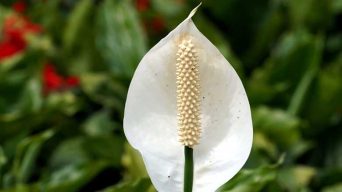Key Takeaways
- Growing a Peace Lily in water can improve indoor air quality, provide low-maintenance care, and offer aesthetic appeal to any indoor environment.
- To successfully grow a Peace Lily in water, it is important to choose the right container and water source, understand its growing requirements such as lighting, temperature, and nutrients; avoid overwatering or using tap water with high chlorine content; use proper humidity control techniques like occasional misting to promote healthy growth and flowering.
- Troubleshooting tips include addressing problems like yellowing leaves caused by overwatering or lack of drainage, mold growth due to excessively moist soil conditions, or high-water demand from the plant. Repotting the plant may be necessary if there aren’t adequate drainage holes for your peace lilies.
Are you seeking a low-maintenance, air-purifying, and visually appealing houseplant? Look no further than the Peace Lily.
This guide will unveil the secrets of growing a Peace Lily in water without potting soil or hydroponics.
Following these simple step-by-step instructions and avoiding common pitfalls, you can easily turn this shade-loving tropical plant into an alluring focal point in your home or workspace.
Benefits Of Growing A Peace Lily In Water
Growing a Peace Lily in water can enhance the air quality, require minimal upkeep, and add a pleasing visual element to any indoor space.
Improved Air Quality
Growing a peace lily in water offers numerous benefits, one of the most significant being its ability to improve indoor air quality.
These hardy plants act as natural filters, effectively removing harmful toxins such as benzene and formaldehyde from the air around them.
Incorporating a water-grown peace lily into your home creates an aesthetically pleasing environment and contributes to a healthier living space.
Imagine breathing cleaner, fresher air while admiring the lush green leaves and elegant white flowers of your thriving peace lily – it’s more than just interior decoration; it’s an investment in well-being.
Low Maintenance
Growing a peace lily in water offers numerous advantages, and one of the most appealing is its low-maintenance nature.
Compared to traditional soil-based houseplants, peace lilies cultivated in water require less attention and care.
As there’s no potting soil involved, you won’t have to worry about messy spills or constantly monitoring moisture levels.
To ensure your peace lily thrives in its watery environment, replace the water every few weeks with fresh distilled water – this helps prevent harmful mineral buildup from tap water that can lead to brown leaf tips.
Additionally, following the product’s recommended dosages, provide your plant with hydroponic fertilizer for essential nutrients.
Aesthetic Appeal
The aesthetic appeal of a peace lily grown in water presents a sleek and modern touch to any indoor space.
Its elegant white flowers, dark green leaves, and exposed root system create an eye-catching display that can elevate the ambiance of your home or office.
Additionally, cultivating peace lilies in water offers opportunities for creative arrangements with other plants like bettas or shade-loving philodendrons.
You can also experiment with different types of glassware to showcase the plant’s unique features visually.
Step-by-Step Guide To Growing A Peace Lily In Water
To grow a peace lily successfully in water, it is vital to understand its growing requirements.
Peace lilies prefer bright indirect light and thrive best in temperatures between 65°F to 80°F.
They can tolerate lower light levels but will not bloom as well.
When propagating peace lilies in water, ensuring the cutting has at least one node above the waterline and that the container is filled with distilled or filtered water is essential.
In addition to proper lighting and water quality, providing adequate nutrients is crucial for a healthy, peace lily plant.
Hydroponic fertilizer is recommended for plants grown in soilless mediums like water since it delivers essential nutrients straight to the roots without affecting pH levels negatively.
Be sure to fertilize your peace lily once every two weeks during its active growing period from spring until fall using a balanced liquid fertilizer diluted according to package instructions.
Choosing The Right Container And Water Source
Choosing the right container and water source is crucial to growing a Peace Lily in water.
A glass or clear plastic container is ideal as it allows enough light penetration for the plants.
The vase should have a narrow neck and widened base to support the plant’s stem while keeping its leaves above water level.
Avoid tap water when choosing a water source because it could contain high chlorine levels that damage your plant roots over time.
Instead, consider distilled or filtered water left out overnight to reach room temperature before use.
Planting The Cutting In Water
You must begin with a cutting to grow your peace lily in water.
This can be a stem or leaf cutting, and choosing one that is healthy and has at least two nodes where new roots will grow is important.
Once you have your cutting, fill a container with distilled or filtered water and place the cutting inside so that the bottom node is submerged.
It’s essential to provide plenty of light for the plant during this stage, but direct sunlight should be avoided as it can scorch the delicate leaves.
As your peace lily develops roots over the next few weeks, change out the water regularly and add hydroponic fertilizer every other week or so.
Providing The Right Light And Temperature
Proper lighting and temperature are crucial for the growth and health of peace lilies.
These tropical plants thrive in bright, indirect light but tolerate low-light conditions.
Avoid placing them in direct sunlight, as it can scorch their leaves.
Peace lilies prefer warm temperatures ranging from 65 – 80 degrees Fahrenheit during the day and slightly cooler at night.
They’re not fans of cold drafts or sudden temperature changes, so keep them away from doors and windows that open frequently.
Nourishing The Peace Lily With Necessary Nutrients
Peace lilies require proper nourishment to thrive, which can be achieved through fertilization.
A balanced liquid fertilizer should be used once a month during the growing season, from spring to fall.
Overfertilizing should be avoided as it can damage the plant.
In addition to fertilization, fresh distilled or filtered water should be provided regularly.
The peace lily’s root system responds best when grown in a soilless medium with nutrients added directly to the water.
Let tap water sit for 24 hours before watering your plant since chlorine levels can harm them over time.
Common Mistakes To Avoid When Growing A Peace Lily In Water
For the healthy growth of a Peace Lily in water, avoiding overwatering, using tap water with high chlorine levels, placing the plant under direct sunlight, and not providing adequate nourishment is important.
Overwatering
Overwatering is one of the most common mistakes when growing a peace lily in water.
While peace lilies thrive in moist conditions, it’s important to note that overwatering can lead to several issues, including root rot and yellowing leaves.
When you overwater, the roots become waterlogged, meaning they cannot absorb the oxygen needed for healthy growth.
This lack of oxygen causes them to “drown” and eventually die.
To avoid overwatering your peace lily, ensure the container has proper drainage holes to prevent water from sitting in the bottom and saturating the roots.
Also, ensure not to let the plant sit in standing water for too long, which can cause damage.
Rather than adhering to a strict watering schedule, check soil moisture levels with your finger before watering again.
Add enough water until it begins draining out from the bottom of the container.
Using Tap Water With High Chlorine Content
Tap water can harm peace lilies, especially those grown in water.
This is because tap water often contains high chlorine levels and other minerals that can damage the plant’s roots and leaves.
To prevent this from happening, it’s best to use distilled or purified water for your peace lilies if you plan on using fertilizer or growing them hydroponically.
If you must use tap water, it’s recommended that you let it sit out overnight before adding it to the container so that some of the chlorine evaporates.
Placing The Plant In Direct Sunlight
Direct sunlight can harm Peace Lilies and cause their leaves to burn, wilt, or become discolored.
If you’re growing your Peace Lily in water, avoid placing it in direct sunlight.
Instead, opt for a bright but indirect light source like an east-facing window or a shaded area near a window with filtered light.
It’s important to note that even if you’re growing a hardy plant like Peace Lilies through hydroponics or soilless mediums, they still need proper care and attention regarding their environment.
Keeping your Peace Lily away from direct sun exposure and providing ample indirect light will ensure its consistent and healthy growth over time.
Neglecting To Provide Proper Nourishment
One of the most common mistakes people make when growing a peace lily in water is not properly nourishing it.
Peace lilies require essential nutrients like nitrogen, phosphorus, and potassium to thrive and grow healthy foliage.
Without these nutrients, you may notice your plant leaves turning yellow or discoloring.
To avoid this issue, ensure you’re using a high-quality water-soluble fertilizer explicitly formulated for indoor plants such as peace lilies.
You can add a few drops of liquid fertilizer to the container monthly during the growing season (spring through summer) to keep your plant healthy and vibrant.
Additionally, consider changing out the water every few weeks and replenishing it with fresh, distilled, or filtered water to prevent any buildup of harmful minerals that could be affecting your plant’s health.
Troubleshooting Tips
If your Peace Lily is experiencing yellowing leaves, mold growth, or root rot, don’t worry!
The following tips can assist you in resolving these problems and keeping your plant healthy and flourishing in water.
Yellowing Leaves
Yellowing leaves is a common issue with peace lilies grown in water, but it can be easily prevented.
One of the most common causes of pale or yellowing foliage is overwatering.
Peace lilies don’t fare well when left sitting in stagnant water for an extended period.
Another cause of yellowing leaves is poor drainage due to improper soil or container size.
If you notice edges turning brown and leaves drooping, it may indicate inadequate drainage.
Consider repotting the plant in fresh soil and a pot with good drainage holes if necessary.
Mold Growth
Mold growth is one of the most common problems of growing peace lilies in water.
It usually occurs due to excessively moist soil conditions caused by overwatering, lack of drainage or air circulation, or high water demand from the plant.
To prevent mold growth and other plant issues, it’s important to choose fast-draining soil for your peace lily and be mindful of how much and how often you’re watering it.
Common signs of mold growth include white or grayish spots on the leaves and an unpleasant smell emanating from the plant.
Root Rot
Root rot is a common problem among houseplants, including peace lilies.
This occurs when the plant’s roots are overwatered and deprived of oxygen, causing them to decay.
Yellowing leaves is a tell-tale sign of root rot in peace lilies, which can also be accompanied by wilting or drooping foliage.
To treat this issue, it’s important to prune affected roots and repot the plant in fresh soil with proper drainage holes.
Watering from below can also help revive a drooping peace lily, allowing the roots to absorb water without being submerged in excess moisture.
Final Thoughts
Growing a Peace Lily in water is a great way to add greenery and aesthetic appeal to your home or office.
With their low maintenance requirements, these beautiful plants are perfect for busy individuals who still want the benefits of houseplants.
Choose the right container and water source, provide proper lighting and temperature, and nourish your Peace Lily with the necessary nutrients.
Avoid common mistakes like overwatering or placing it in direct sunlight.
And don’t forget about troubleshooting tips for yellow leaves or root rot.







